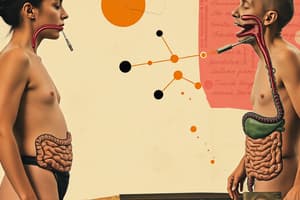Podcast
Questions and Answers
What is the primary role of the digestive system?
What is the primary role of the digestive system?
- To produce energy directly from food
- To directly absorb oxygen from food
- To filter toxins from the blood
- To break down large food molecules into smaller molecules (correct)
Which of the following organs is not part of the alimentary canal?
Which of the following organs is not part of the alimentary canal?
- Stomach
- Liver (correct)
- Small intestine
- Esophagus
Where does the alimentary canal begin in the human body?
Where does the alimentary canal begin in the human body?
- Stomach
- Anus
- Pharynx
- Mouth (correct)
How long is the human alimentary canal approximately?
How long is the human alimentary canal approximately?
Which component of the digestive system is responsible for the mechanical processing of food?
Which component of the digestive system is responsible for the mechanical processing of food?
What structure is found at the beginning of the alimentary canal?
What structure is found at the beginning of the alimentary canal?
Which type of gland secretes digestive juices in the alimentary canal?
Which type of gland secretes digestive juices in the alimentary canal?
What is the main function of the vestibule in the oral cavity?
What is the main function of the vestibule in the oral cavity?
What role do enzymes play in the digestive system?
What role do enzymes play in the digestive system?
Which of these organs is responsible for the absorption of nutrients?
Which of these organs is responsible for the absorption of nutrients?
Flashcards
Digestion
Digestion
The process of breaking down large food molecules into smaller, simpler molecules that the body can absorb and use.
Ingestion
Ingestion
The taking in of food by an organism.
Absorption
Absorption
The process by which digested nutrients pass from the digestive tract into the bloodstream.
Egestion
Egestion
Signup and view all the flashcards
Alimentary Canal
Alimentary Canal
Signup and view all the flashcards
Vestibule
Vestibule
Signup and view all the flashcards
Mouth
Mouth
Signup and view all the flashcards
Tongue
Tongue
Signup and view all the flashcards
Salivary Glands
Salivary Glands
Signup and view all the flashcards
Esophagus
Esophagus
Signup and view all the flashcards
Study Notes
Digestion and Absorption
- Living organisms require energy for survival, which is obtained from food.
- Food provides essential materials for growth and biological functions.
- Food is ingested or synthesized, with large molecules broken down into smaller molecules.
- The digestive system modifies complex foods and absorbs nutrients and minerals.
- Digestive enzymes and juices are crucial for food digestion, secreted by glands.
Structure of the Human Alimentary Canal
- The alimentary system is responsible for ingestion, digestion, absorption and egestion.
- The system consists of two main parts: the alimentary canal (a tube-like structure) and accessory glands.
- The alimentary canal begins at the mouth and ends at the anus.
- The canal's length is approximately 9 meters.
- Key parts/organs include: mouth, pharynx, esophagus, stomach, small intestine, large intestine, and anus.
Mouth and Vestibule
- The mouth contains an outer part called the vestibule and an inner part called the oral cavity.
- The vestibule is a slit-like area bordered by lips and cheeks externally, and gums and teeth internally.
- It opens to the exterior between the upper and lower lips.
Studying That Suits You
Use AI to generate personalized quizzes and flashcards to suit your learning preferences.




